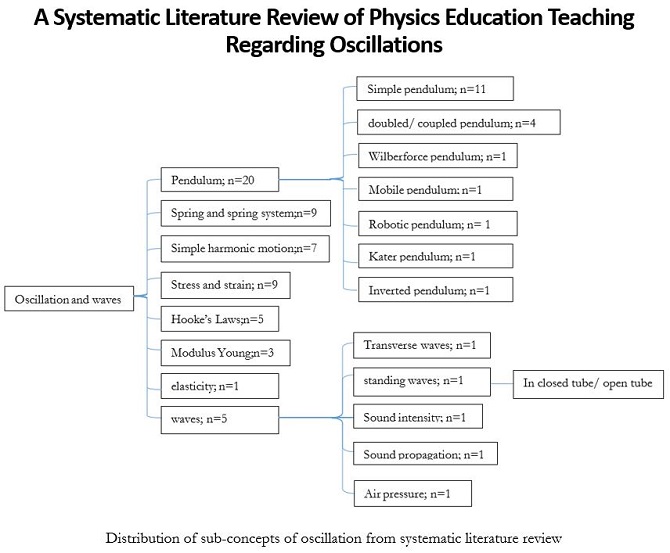
A Systematic Literature Review of Science and Physics Education Teaching Regarding Oscillations
Abstract
Full Text:
Download PDFReferences
Aygün, B. M., & Hacıoğlu, Y. (2022). Teaching the Sound Concept : A Review of Science and Physics Education Postgraduate Theses in Turkey. Athen Journal of Education, 9(2), 257–275.
Banda, H. J., & Nzabahimana, J. (2023). The Impact of Physics Education Technology (PhET) Interactive Simulation-Based Learning on Motivation and Academic Achievement Among Malawian Physics Students. Journal of Science Education and Technology, 32(1), 127–141. https://doi.org/10.1007/s10956-022-10010-3
Bathgate, M. E., Aragón, O. R., Cavanagh, A. J., Waterhouse, J. K., Frederick, J., & Graham, M. J. (2019). Perceived supports and evidence-based teaching in college STEM. International Journal of STEM Education, 6(1), 1–14. https://doi.org/10.1186/s40594-019-0166-3
Batlolona, J. R., Diantoro, M., Wartono, & Latifah, E. (2019). Creative thinking skills students in physics on solid material elasticity. Journal of Turkish Science Education, 16(1), 48–61. https://doi.org/10.12973/tused.10265a
Batlolona, J. R., Diantoro, M., Wartono, & Leasa, M. (2020). Students’ mental models of solid elasticity: Mixed method study. Journal of Turkish Science Education, 17(2), 200–210. https://doi.org/10.36681/tused.2020.21
Borrachero, A. B., Brígido, M., Dávila, M. A., Costillo, E., Cañada, F., & Mellado, V. (2019). Improving the self-regulation in prospective science teachers: the case of the calculus of the period of a simple pendulum. Heliyon, 5(12). https://doi.org/10.1016/j.heliyon.2019.e02827
Chiriacescu, B., Chiriacescu, F. S., Miron, C., Berlic, C., & Barna, V. (2020). Arduino and tracker video – didactic tools for study of the kater pendulum physical experiment. Romanian Reports in Physics, 72(1), 1–14.
Chong, S. W., Lin, T. J., & Chen, Y. (2022). A methodological review of systematic literature review in higher education: Heterogeneity and homogeneity. Educational Research Review, 2022, 2–37.
da Silva, O. H. M., Laburú, C. E., Camargo, S., & Chistófalo, A. A. C. (2019). Epistemological contributions derived from an investigative method in an experimental class in the study of Hooke’s law. Acta Scientiae, 21(2), 110–127. https://doi.org/10.17648/acta.scientiae.v21iss2id4695
Dandare, K. (2018). A study of conceptions of preservice physics teachers in relation to the simple pendulum. Physics Education, 53(5), aac92f. https://doi.org/10.1088/1361-6552/aac92f
Farrokhnia, M. (2020). Student-Generated Stop-Motion Animation in Science Classes : a Systematic Literature Review. Journal of Science Educa, 29(9), 797–812.
Garcés-Gómez, Y. A., López, P. A., Cárdenas, O. O., Henao-Cespedes, V., & Toro-García, N. (2020). Experimental verification of two theoretical solutions of the pendulum for large angles in frequency domain for teaching support. International Journal of Interactive Mobile Technologies, 14(8), 140–149. https://doi.org/10.3991/IJIM.V14I08.12607
Hauko, R., Andreevski, D., Paul, D., Šterk, M., & Repnik, R. (2018). Teaching of the harmonic oscillator damped by a constant force: The use of analogy and experiments. American Journal of Physics, 86(9), 657–662. https://doi.org/10.1119/1.5044654
Ingram, A. R., & Motta, S. E. (2020). A review of quasi-periodic oscillations from black hole X-ray binaries : Observation and theory. New Astronomy Reviews, 85(September 2019), 101524. https://doi.org/10.1016/j.newar.2020.101524
Ionascu, C. (2022). VIRTUAL EXPERIMENTS FOR MEASURING FUNDAMENTAL PHYSICAL QUANTITIES. Romanian Reports in Physics, 74(4). https://api.elsevier.com/content/abstract/scopus_id/85141884433
Israilov, S., Fu, L., Sánchez-Rodríguez, J., Fusco, F., Allibert, G., Raufaste, C., & Argentina, M. (2023). Reinforcement learning approach to control an inverted pendulum: A general framework for educational purposes. PLoS ONE, 18(2 February), 1–15. https://doi.org/10.1371/journal.pone.0280071
Krnic Martinic, M., Pieper, D., Glatt, A., & Puljak, L. (2019). Definition of a systematic review used in overviews of systematic reviews, meta-epidemiological studies and textbooks. BMC Medical Research Methodology, 19(1), 1–12. https://doi.org/10.1186/s12874-019-0855-0
Kurniawan, B. R., Kusairi, S., Puspita, D. A., & Kusumaningrum, R. W. (2021). Development of Computer Based Diagnostic Assessment Completed with Simple Harmonic Movement Material Remedial Program. Jurnal Pendidikan Fisika Indonesia, 17(1), 1–12. https://doi.org/10.15294/jpfi.v17i1.18540
Lisboa, A., Peña, F. J., Negrete, O., & Dib, C. O. (2021). Teaching labs for blind students: Equipment to measure standing waves on a string. European Journal of Physics, 42(6). https://doi.org/10.1088/1361-6404/ac18b6
Mallidis-Malessas, P., Iatraki, G., & Mikropoulos, T. A. (2022). Teaching Physics to Students With Intellectual Disabilities Using Digital Learning Objects. Journal of Special Education Technology, 37(4), 510–522. https://doi.org/10.1177/01626434211054441
McComas, W. F., & Burgin, S. R. (2020). A Critique of “STEM” Education: Revolution-in-the-Making, Passing Fad, or Instructional Imperative? Science and Education. https://doi.org/10.1007/s11191-020-00138-2
Nyirahabimana, P., Minani, E., Nduwingoma, M., & Kemeza, I. (2022). A scientometric review of multimedia in teaching and learning of physics. LUMAT, 10(1), 89–106.
Powell, J. T., & Koelemay, M. J. W. (2022). Systematic Reviews of the Literature Are Not Always Either Useful Or the Best Way To Add To Science. EJVES Vascular Forum, 54(i), 2–6. https://doi.org/10.1016/j.ejvsvf.2021.10.021
Price, C. B., & Mohr, R. P. (2019). PhysLab: A 3D virtual physics laboratory of simulated experiments for advanced physics learning. Physics Education, 54(3). https://doi.org/10.1088/1361-6552/ab0005
Purba, S. W. D., & Hwang, W. Y. (2018). Investigation of learning behaviors and achievement of simple pendulum for vocational high school students with Ubiquitous-Physics app. Eurasia Journal of Mathematics, Science and Technology Education, 14(7), 2877–2893. https://doi.org/10.29333/ejmste/90985
Rinaldi, R. G., & Fauzi, A. (2020). A complete damped harmonic oscillator using an Arduino and an Excel spreadsheet. Physics Education, 55(1), ab539d. https://doi.org/10.1088/1361-6552/ab539d
Sumardi, Y., Amalia, A. F., & Prabowo, U. N. (2022). Develoment of The Computer Simulation of Oscillation in Physics Learning. Jurnal Pendidikan Fisika Indonesia, 18(1), 33–44. https://doi.org/10.15294/jpfi.v18i1.29040
Tinmaz, H., Lee, Y. T., Ivanovici, M. F., & Baber, H. (2022). A systematic review on digital literacy. Smart Learning Environments, 9(21), 1–18. https://doi.org/10.1186/s40561-022-00204-y
Volfson, A., Eshach, H., & Ben-Abu, Y. (2021). When Technology Meets Acoustics: Students’ Ideas About the Underlying Principles Explaining Simple Acoustic Devices. Research in Science Education, 51(4), 911–938. https://doi.org/10.1007/s11165-019-09913-w
Zhong, B., & Xia, L. (2020). A Systematic Review on Exploring the Potential of Educational Robotics in Mathematics Education. International Journal of Science and Mathematics Education, 18(5), 79–101.
DOI: https://doi.org/10.17509/jsl.v7i1.57765
Refbacks
- There are currently no refbacks.
Copyright (c) 2024 Yudi Kurniawan, Achmad Samsudin, Andi Suhandi

This work is licensed under a Creative Commons Attribution-ShareAlike 4.0 International License.


Jl. Dr. Setiabudhi 229 Bandung 40154, West Java, Indonesia










